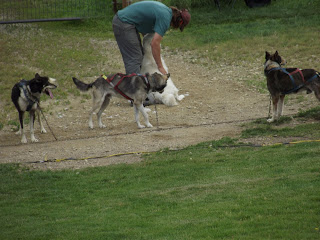Much is made of the long summer daylight hours of Alaska. On June 21 of each year they have 21 hours, 45 minutes of daylight. Okay, we're not here then but close. Using no artificial light these photos were taken last night/morning at 11pm, 1:30am, 4:00am respectively.
Jerry and Gail decided stay to with Heidi at the RV park.
Lon and Pam opted to go exploring. First a visit to the Alaskan Pipeline (very impressive)
- The Trans Alaska Pipeline System was designed and constructed to move oil from the North Slope of Alaska to the northern most ice-free port in Valdez, Alaska.
- Length: 800 miles.
- Diameter: 48 inches.
- Crosses three mountain ranges and more than 30 major rivers and streams.
- Cost to build: $8 billion in 1977, largest privately funded construction project at that time.
- Construction began March 27, 1975 and was completed May 31, 1977.
- First oil moved through the pipeline on June 20, 1977.
- More than 16 billion barrels have moved through TAPS.
- First tanker to carry crude oil from Valdez: ARCO Juneau, August 1, 1977.
- Tankers loaded at Valdez: 19,625 through April 30, 2008.
Then they went to check out the Silver Gulch Micro Brewery
After which came a ride on the Discovery III paddle wheeler that provides a 3.5 hour trip on the Chena River and some history of old Alaska:

The Chena River is a 100-mile-long (160 km) river in the Interior region of the U.S. state of Alaska. It flows generally west from the White Mountains to the Tanana River near the city of Fairbanks, which is built on both sides of the river. The 2300 mile-long Yukon River flows from both the Tanana and Chena Rivers.
They had free coffee and donuts. Lon thought he was "back on the job".
Due to the vast size of the Alaskan wilderness, airplanes are a critical mode of transportation and cargo movement. 1 in every 60 Alaskans is a licensed pilot. We were treated to a float plane departure near our boat.

It's not unusual to see float planes on the rivers or airplanes parked next to a house.
We had a demonstration of sled dogs by David Monson husband of the late Susan Butcher, Four Time Iditarod Sled Dog Race Champion. He talked about the dogs, training and his beloved iconic wife.
There were many beautiful homes along the river and many not so beautiful. An acre on the river goes for about $150k.
Next stop was a preserved Athabaskan indian village where we learned about the culture of the natives of this incredibly beautiful yet hard land.
Cue the Reindeer
Many log homes like these are common in modern Athabaskan villages.
They still trap and hunt, Lon thought this was the best use for a Wolverine he'd ever seen
They use these fish wheels to catch fish (that's my idea of fishing)
Pam's new camera got a workout
The flowers, in fact all vegetation, grow quite large due to the long days in the summer
We got back and Jerry had a new sign on his coach
He fixed us italian sausages
Then we went looking for moose. No moose but have you ever seen skies like this?
Oh well, maybe tomorrow...........





























No comments:
Post a Comment